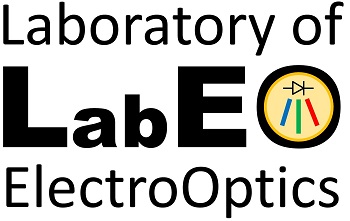The research activities carried out at the Laboratory of ElectroOptics of the University of Pavia are focused on the field of optoelectronics, in collaboration with Italian and foreign Universities and companies, with regard to the study, design and characterization of new components and measuring systems, relative to biomedical and industrial applications.
Our expertises
- Optoelectronics
- Micro-opto-fluidics
- Characterization of MEMS and MOEMS
- Laser Telemetry
- Laser Interferometry
- Network Security
- Photonic devices
- NIR-SWIR technologies
On going Projects
Below is a summary and description of current research activities.
Concluded Projects
Below is a summary and description of previous projects:
MUSKETEER: Milk adUlteration detection using SpecKlE paTtern and machinE lEaRning
The project is founded by PRIN: PROGETTI DI RICERCA DI RILEVANTE INTERESSE NAZIONALE
Started on December 2023. Duration: 2 years.
Aim of the MUSKETEER project is the design, implementation and demonstration of a novel, easy-to-use and portable smart platform, able to identify adulterations of fluid dairy products, in a contactless manner. In the system that we are proposing, quality
assessment of milk samples is achieved by real-time AI-based processing of speckle pattern images acquired using a camera, by
illuminating small volumes of the fluid under test with laser light.
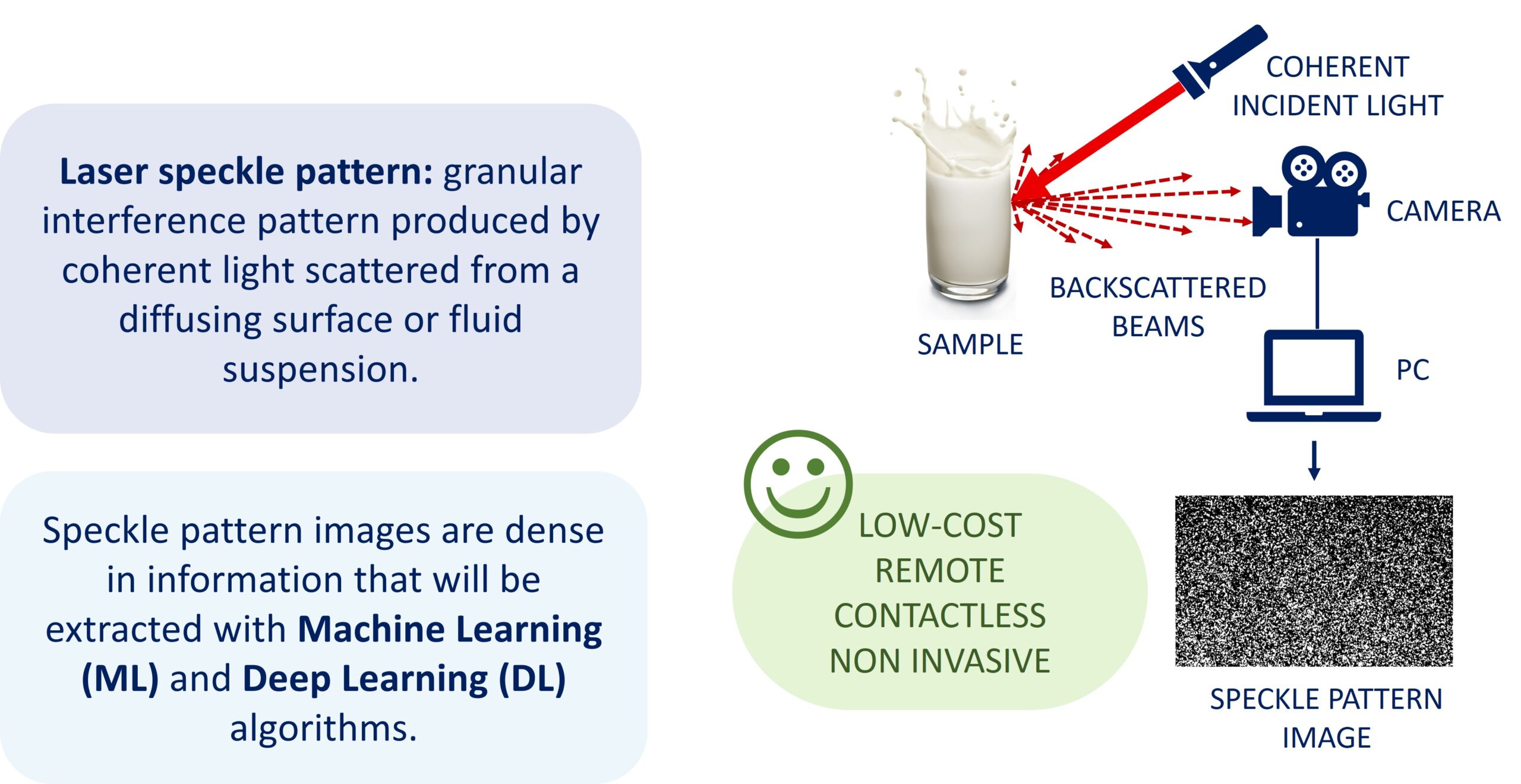
Laser speckle is the granular interference pattern produced by coherent light scattered from a diffusing fluid, such as a suspension, or surface, and consists of a random distribution of bright and dark spots.
We plan to excite speckle patterns with multi-wavelength illumination and to investigate instrumental configurations working in reflection or in transmission, with the aim to find the most efficient source-sample-detector deployment scheme.
Sequences of images of the speckle pattern are dense in information that needs to be pulled out: we want to demonstrate that, by
smart data processing methods, several parameters can be extracted and correlated with the main properties of the milk sample under test (e.g. content of lipids, carbohydrates and proteins, and state of adulteration of the milk).
Among the plethora of algorithms available to process image data, we propose to adopt machine learning and deep learning models
that we believe are the most promising. By using them, we plan to directly elaborate visual data without the need of a specialized
hand-designed processing pipeline.
We aim to design an embedded platform that can control the acquisition devices (camera and laser) and process acquired images using AI-algorithms. The prototype will include the necessary hardware to perform laser speckle imaging and processing in a compact fashion, while keeping in mind the affordability of components.
The ACOUSTIC project
Development of integrated circuits, algorithms and mechano-acoustic technologies to transform generic surfaces into radiant acoustic elements with very high efficiency
The project (N.ro MISE F/310010/01/X56) is founded by the Ministry of Enterprises and Made in Italy
Started on January 2023. Duration: 3 years.
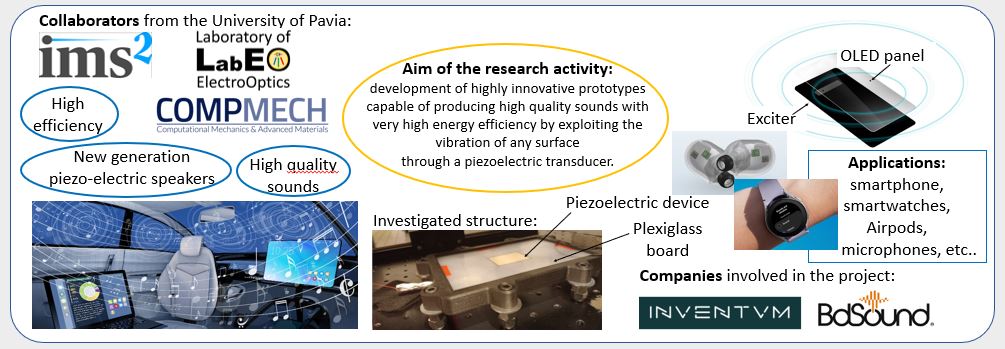
One of the main themes of the research activity is the modeling and simulation of the speaker systems in order to study their mechanical and acoustic behaviour e.g. vibration modes, resonances, distortions, developed sound pressure and interaction with the supporting structures.
With regard to the characterization of dynamic behavior through optical techniques, the development and application of different instrumental configurations based on laser interferometry have been proposed, even at different wavelengths, to be able to choose, case by case, the measurement system that ensures the best performances for the type of surface under examination.
The Laboratory of ElectroOptics of the University of Pavia is taking part in the Acoustic project as research partner working on the characterization of piezo-transducers by means of interferometric techniques.
Smart Micro-Opto-Fluidic Devices
We are developing new smart micro-opto-fluidic systems for non-invasive, contactless and label-free optical detection of substances by means of innovative and advances optical techniques. In particular, our recent works are focused on the implementation of smart and biocompatible micro-opto-fluidic sensing platforms based on NIR-SWIR spectroscopy (wavelength range: 1000 nm – 2500 nm).
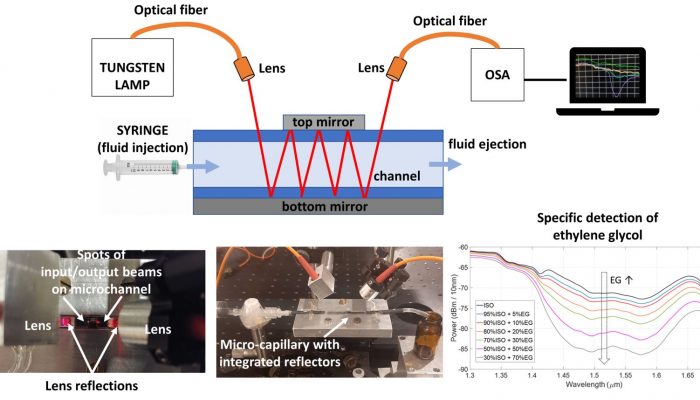
The figure above shows the optoelectronic instrumental configuration used to distinguish harmful ethylene glycol from isopropanol in the NIR wavelength region. For more information see our latest publication in Sensors: click here!
We are moving towards the development of sensors for the quantification of fluids composition using short-wave infra-red (SWIR) spectroscopy, exploring wavelength regions up to 2 micrometers. Such sensors can be applied in several fields, from pharmaceutics and chemical to food quality and safety.
Laser Telemetry
Time-of-Flight Telemeter with a Ring Laser
Time-of-flight telemeters are based on the measurement of the time required by the laser radiation to cover the round trip distance to a target.
In Ring lasers different regimes have been theoretically predicted and experimentally observed, including bistability between the two clockwise, counter-clockwise (CW/CCW) modes. A telemeter can be designed based on this regime.
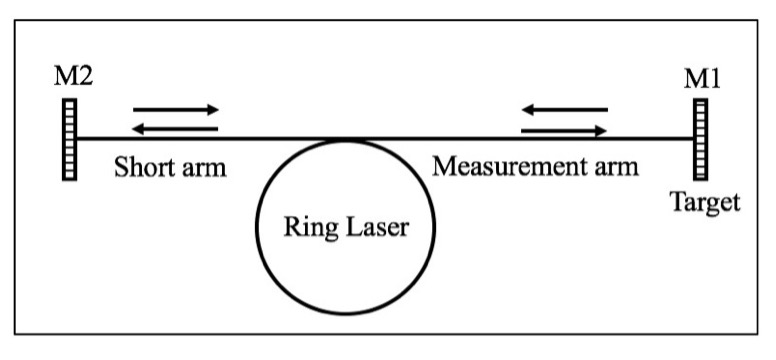
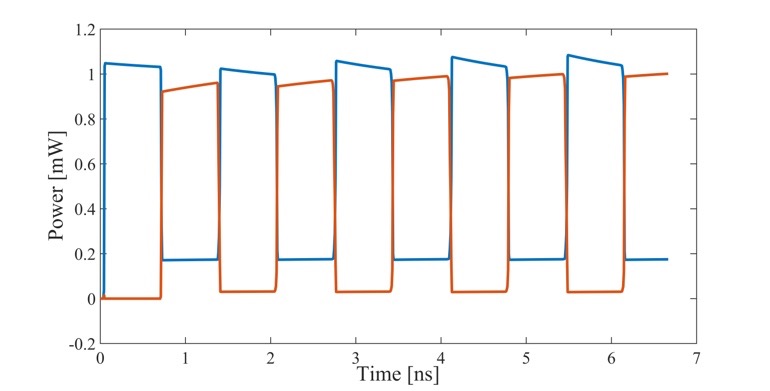
Indeed, suppose that at a given time the laser is in the CW regime. The radiation emitted from one ring-laser end (right end in Fig.1) is reflected back by the target and after a round trip time, which depends on the laser-target distance, it re-enters the laser cavity in opposite direction and, for proper operating conditions, switches the laser to CCW. The laser emission from the other output (left end in Fig.1) is directed toward a nearer (and fixed) local mirror along a short optical path to switch the laser back to CW, so that the operation can start again, producing a periodic variation of the power direction inside the cavity, which can be detected, for example, by a photodiode positioned behind the local (partial) mirror. Since the first round trip time depends on the laser-target distance, while the second is constant, the laser-target distance can be measured from the oscillation period.
Laser Interferometry
Network Security by Chaotic Lasers
Optical Chaotic Cryptography
The chaotic regime is a well-known behaviour of a large class of nonlinear systems and consists of pseudo-random oscillations, which are reproducible only by identical initial conditions and parameter values.
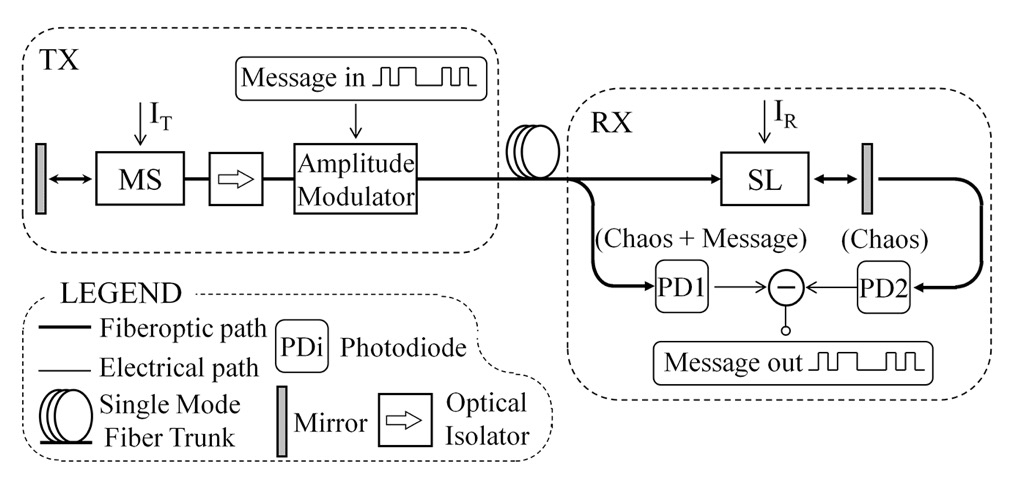
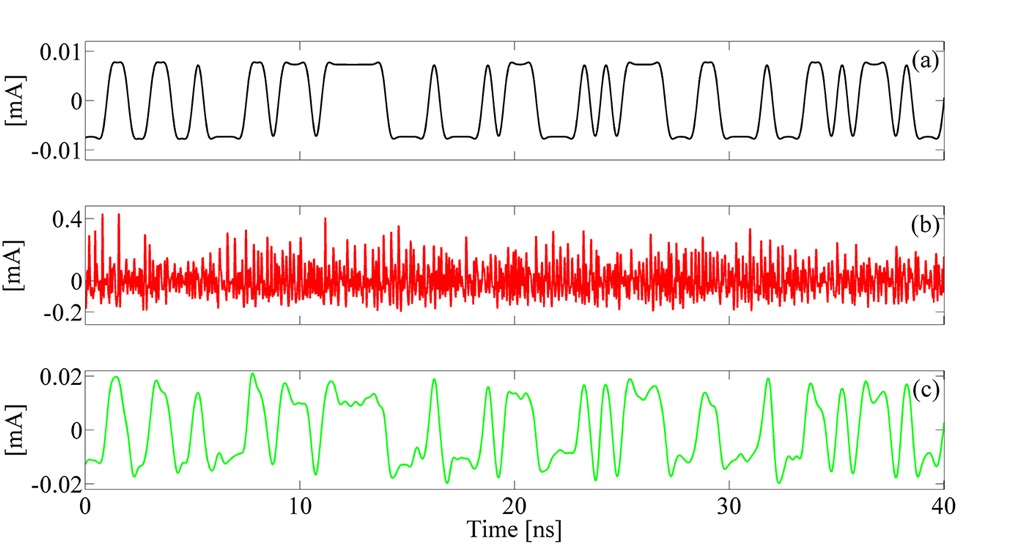
The basic approach to chaos secured data transmission consists in hiding a message into the very complex noise-like waveform generated by a chaotic laser (Fig.1). This can be done simply superposing chaos to the message at the transmitter (Tx), in order to strongly reduce its SNR. The composite signal is then transmitted through the fibre link. Message recovery is usually based on a master/slave synchronization scheme: another laser (the slave, SL) is used at the receiver (Rx), and its parameters are matched with those of the transmitter laser (the master, MS). The composite waveform (chaos + message) from the optical link is injected into the slave. Under suitable operating conditions the slave laser to synchronizes to the master chaos, (i.e., the two devices generate almost exactly the same chaotic waveform), without, however, synchronizing the message. Then, the message can be extracted by making the difference between the received composite signal and the recovered chaotic waveform (Fig.2). The degree of matching required for efficient synchronization is significantly high. A suitable pair of devices (‘twins’) has to be selected in close-proximity from the same wafer. This laser pair represents the (hardware) cryptographic key.
Chaotic lasers provide Physically Unclonable Functions for network authentication
Physical Unclonable Functions (PUFs) have been proposed as an alternative to standard authentication protocols, especially for the Internet of Things applications. With PUFs, secret data are derived from complex physical characteristics of ICs or other electronic devices. In the optoelectronic domain, semiconductor lasers are possible candidates for such method of authentication (Fig.1).
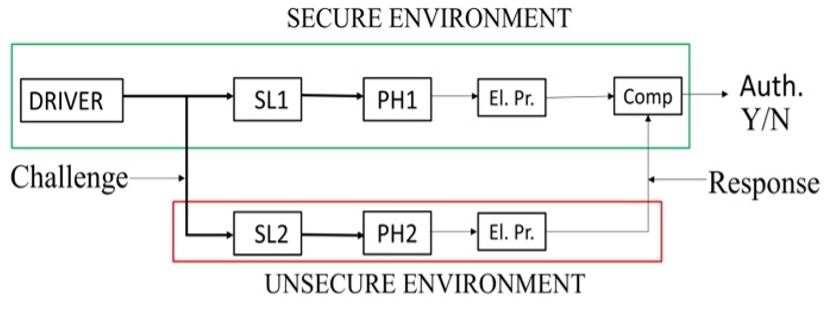
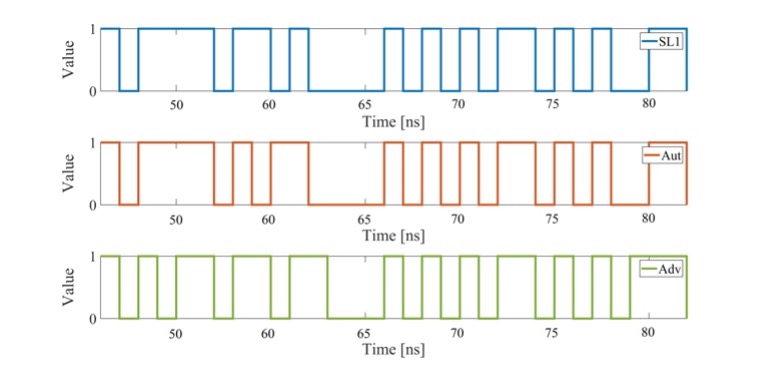
If SL1,2 have very well-matched parameters (twin lasers), in suitable operating conditions they produce the same chaotic modulation, i.e., they synchronize. A bit sequence can be easily obtained from the chaotic lasers by photodetection and digital processing (Fig.2). The response in the unsecure environment is the bit stream produced by Slave SL2 (Authorized vs. Adversary). The reference response in the secure environment is the bit stream generated by SL1. Only if the two responses match authorization is granted.
Concluded Projects
The Digital Smart Fluidic project: Artifical nutrition monitoring at home
Artificial nutrition at home is a research topics that the Digital Smart Fluidic (DSF) project focuses on. The DSF project is one of the winners of the “Research and Innovation Hub” POR FESR 2014-2020 call for tender of Regione Lombardia, that provides financial support to the of development of new technologies and facilities on the territory. The project is headed by Fluid-o-Tech, with the strong collaboration of University of Pavia, Fondazione I.R.C.C.S. Policlinico San Matteo and other companies.
The Laboratory of ElectroOptics of the University of Pavia is taking part in the DSF project as research partner working on the development of an opto-fluidic device to be applied to artificial parenteral nutrition at home. This activity focuses on the development of a smart optical sensor that recognizes the type of Parenteral Artificial Nutrition (PAN) fluid that is being delivered to the patient’s body and checks its compliance with the nutrition mixture prescribed by the doctor team. This sensor will be integrated in a smart commercial delivery pump and, if needed, will communicate an alert message to the patient, constituting a security check system that can make artificial nutrition at home safer. In this way, the patients will be able to manage themselves the PAN system at home without the constant intervention of the nursing staff, making feel them more autonomous and comfortable with PAN.

For more information regarding the DSF project: click here! and read our latest publication in Sensors: click here!
Spectral Phase Shift Interferometry and Advance Piezoelectric Devices Project
Optical resonances can be identified by using a method based on interferometric phase interrogation. We propose a spectral interferometric technique for detecting the wavelength positions of the resonances of rectangular glass micro-capillaries: the spectral reflectivity of the micro-devices can be explored when they are placed at the end of the measuring arm of a Michelson scheme. Optical resonances of these low-cost optical resonators correspond to the positions of steep phase jumps on the interferometric cosine signal acquired with an optical spectrum analyzer. To the best of our knowledge, it is the first time that this method is employed for the detection of the wavelength positions of optical cavity resonances.
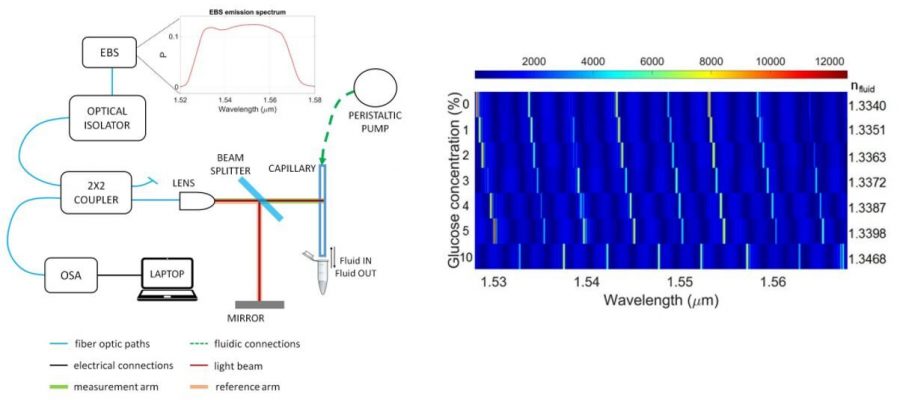
The figure above shows the optoelectronic instrumental configuration based on interferometry. We successfully demonstrated that the capillary can be inserted in a microoptofluidic setup and the wavelength positions of the steep jumps in the cosine signal depend on the RI of the filling fluid. The spectral phase shift interferometric technique can be efficiently employed for sensing the RI of ultralow volumes of fluids.
For more information see our publication in IEEE Transactions on Intrumentation and Measurement: click here!
MOEMS Characterization and Piezoelectric Devices
In our laboratory, we develop advance optical systems to measure vibrations and to characterize micro-systems.
To find the resonance frequencies and mode shapes of a micro-plate, an optical instrument for non-contact dynamic characterization is required. The dynamic response of micro-devices can be successfully characterized with optical methods based on interferometric measurements performed in just a few well selected spots on the structure. This approach is easily accessible and low-cost in comparison with conventional laser doppler vibrometers; therefore, we carried out the modal analysis of piezo-actuated microplates, which are buckled due to the built-in stress, using a compact, fiber-based interferometric setup.

For more information see our latest publication in Sensors and Actuators A:Physical: click here! (In collaboration with the University College of Southeast Norway)
